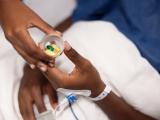Researchers at the University of Utah have identified a method to rapidly identify drugs that can work together to form a potentially powerful weapon against antibiotic-resistant infections, according to a new study in PLoS Biology.
The method makes it easier to identify drugs already approved by the Food and Drug Administration (FDA) that can form "synergistic" combinations that significantly boost their effectiveness against resistant bacteria, with activity that can be four times more powerful than the sum of each individual drug's activity. The authors of the study believe these synergistic drug pairings represent an additional strategy against the growing threat of antibiotic resistance, one that's cheaper and less time-consuming than the search for new antibiotics and could possibly have a quicker clinical impact.
"By pairing FDA-approved drugs synergistically, we have the potential to take these pairs to clinic much more quickly than new drugs, which can be expensive and time-intensive to create and approve," corresponding author and University of Utah pathologist Jessica Brown, PhD, said in a university press release.
The search for synergy
Synergistic drug pairings have long been seen as a potential strategy against bacterial pathogens. Two molecules that are known to work synergistically are the antibiotics trimethoprim and sulfamethizole, used commonly in the treatment of a variety of bacterial infections, such as middle ear and urinary tract infections. But few such pairings have been identified, and finding them is difficult. As Brown and her colleagues note in the study, a collection of 1,000 molecules has 1 million potential pairings.
By using an approach known as the overlap² method (O2M), the researchers have found a way to identify synergistic molecules more quickly. O2M is based on the idea that when a collection of "mutant" pathogens (each missing a specific gene) is grown in the presence of different molecules, those molecules will produce a chemical genetic signature. When those molecules have similar chemical genetic signatures, it's an indication of synergy.
In turn, the identification of mutants that respond similarly when treated with known synergistic molecules enables the identification of additional molecule combinations that work synergistically, much more quickly than tradition screening methods.
"It uses the idea that if you have a synergistic pair, it will elicit a response in a bacterial mutant," co-author Morgan Wambaugh, a PhD candidate in Brown's lab, explained to CIDRAP News. "Then, if you get this response in that same mutant with other drugs that are also known to synergize with that input, you can keep going faster and faster, looking for any drug that elicits the same response in that mutant."
To test this method, the team grew a collection of 4,000 Escherichia coli mutants in the presence of 100 FDA-approved drugs, looking for chemical genetic signatures similar to trimethoprim and sulfamethizole. They identified five molecules that could act synergistically with trimethoprim and sulfamethizole. They also identified a set of four mutants that all exhibited the same phenotypic response to those molecules. These mutants were then used to screen a library of 2,000 molecules for further hits. That produced 14 novel synergistic combinations with trimethoprim, in less than a week.
A new use for an old drug
Of the drugs that paired with trimethoprim, the one the team is most excited about is the antiretroviral drug azidothymidine (AZT), which was originally developed as a chemotherapy candidate and became the first drug used in the treatment of HIV-AIDS. When tested in vitro against clinical isolates of multidrug-resistant E coli and Klebsiella pneumoniae, the synergistic combination proved effective, even against those isolates that were resistant to trimethoprim/sulfamethizole.
The power of the pairing stems from the fact that both drugs damage bacterial DNA, but in different ways. While AZT blocks DNA replication, trimethoprim interferes with the mechanism that bacteria uses to repair DNA damage. As a result, DNA damage accumulates in bacterial cells treated with the two drugs, and microbial growth is inhibited.
Understanding the way that the two drugs work together—a process that has to this point been poorly understood—enabled the team to see if AZT could form a synergistic pairing with drugs that work similarly to trimethoprim but don't have resistance issues. Pairing AZT with the cancer drug floxuridine produced similar results in the clinical E coli and K pneumoniae isolates. When the pairing was tested in zebrafish embryos injected with trimethoprim-resistant E coli, it reduced the bacterial load by 10,000-fold compared with the embryos treated with the combination of trimethoprim and sulfamethizole.
"Just by looking at the mechanism between AZT and trimethoprim, we can hypothesize other drugs that we can use in the combination," Wambaugh said.
The team also used O2M to identify potential synergistic partners for the antibiotic vancomycin, and was able to find three candidates. Wambaugh said they will now go back to that research to better understand the underlying mechanisms of those combinations and see if they can get more hits. And since AZT and floxuridine are already FDA-approved, they're also talking with clinicians to see if they would be willing to test the pairing on difficult-to-treat MDR infections.
See also:
Jun 20 PLoS Biol study
Jun 20 University of Utah press release























